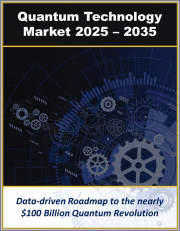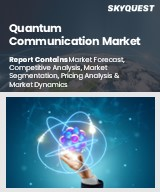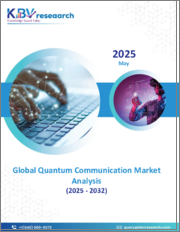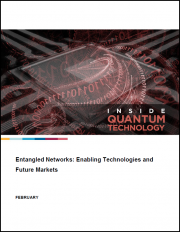
|
시장보고서
상품코드
1700071
세계의 양자기술 시장 예측(-2032년) : 컴포넌트 유형, 투자 유형, 기술 유형, 용도, 최종 사용자, 지역별 분석Quantum Technology Market Forecasts to 2032 - Global Analysis By Component Type (Hardware, Software and Services), Investment Type, Technology Type, Application, End User and By Geography |
||||||
Stratistics MRC에 따르면 세계 양자기술 시장은 2025년 16억 2,900만 달러를 차지할 전망이며, 예측 기간 동안 CAGR 23.0%로 성장하여 2032년에는 69억 3,830만 달러에 이를 것으로 예측됩니다.
양자기술은 원자나 소입자의 에너지 레벨이라는 최소 스케일의 자연계의 기본 이론인 양자역학의 원리에 의한 일련의 첨단기술입니다. 양자기술은 다양한 부문에서 획기적인 용도 개발에 이용됩니다.
계산 능력 향상에 대한 수요 증가
시장에서의 계산 능력 향상에 대한 수요 증가는 기존의 컴퓨터에서는 대응할 수 없는 복잡한 문제를 해결할 필요성에 의해 초래되고 있습니다. 신약 개발, 최적화, 암호화 등의 작업을 위해 보다 빠르고 강력한 컴퓨팅 능력이 요구되고 있습니다.
큐비트 불안정성 및 오류 정정
큐비트의 불안정성과 효과적인 오류 정정의 필요성은 시장에서 큰 과제입니다. 신뢰성 높은 성능을 보장하기 위해서는 견고한 오류 정정 기술의 개발이 필수적입니다. 산업이 발전함에 따라 이러한 과제를 극복하는 것이 복잡한 실제 세계 애플리케이션에서 양자 기술의 잠재력을 극대화하는 핵심 요소입니다.
양자 통신 인프라 진보
양자 통신 인프라의 진화는 매우 안전한 데이터 전송을 가능하게 하고, 시장에 변화를 가져오고 있습니다. 이러한 진보는 데이터 보안이 가장 중요하게 여겨지는 은행, 방위, 의료 등의 산업에 매우 중요합니다.
표준화 부족
시장에서의 표준화의 부족은 상호 운용성을 방해하고 진보를 지연시킵니다. 확립된 프로토콜이나 통일된 가이드라인이 없으면, 서로 다른 양자 시스템은 통신이나 통합이 어려우며 기업이나 연구기관의 협력이 제한될 가능성이 있습니다. 이러한 부문화는 비효율성과 비용 증가를 초래하고 양자 기술의 보급을 지연시킵니다.
COVID-19의 영향
COVID-19의 유행은 연구 프로젝트를 늦추고 공급망을 지연시켜 자원을 양자기술 개발에서 긴급 공중 보건 문제로 집중시키면서 시장을 혼란 시켰습니다. 그러나 동시에 양자 컴퓨팅과 양자 통신을 포함한 첨단 기술이 세계의 과제에 임하는 데 중요하다는 것을 부각시켜 왔습니다. 그 결과 팬데믹 후의 회복에 의해 양자 연구에 대한 관심과 투자가 다시 높아지고, 이 부문에서의 장기적인 혁신과 응용이 가속되고 있습니다.
예측 기간 동안 양자 시뮬레이션 부문이 최대가 될 전망
양자 시뮬레이션 부문은 예측 기간 동안 가장 큰 시장 점유율을 차지할 것으로 예상됩니다. 분자간 상호작용과 재료 특성에 대한 전례 없는 수준의 정확도로 인사이트를 얻을 수 있습니다.
예측 기간 중 항공우주 및 방위 부문의 CAGR이 가장 높아질 전망
예측 기간 동안 항공우주 및 방위 부문이 가장 높은 성장률을 보일 것으로 예상됩니다. 항공우주 설계와 방위 전략 시뮬레이션에 혁명을 가져올 가능성을 갖고 있습니다.
최대 점유율 지역
예측 기간 동안 아시아태평양이 가장 큰 시장 점유율을 차지할 것으로 예상됩니다. 아시아태평양 국가들은 양자 컴퓨팅, 통신, 암호화 기술의 발전에 주력하고 있으며, 정부가 지원하는 이니셔티브와 학술계와 산업계의 협업이 진행되고 있습니다. 이 지역은 통신, 사이버 보안, 제조업에의 응용에 의해 양자 연구의 세계의 거점으로서 대두하고 있어, 세계의 양자 기술 전망에 있어서의 중요한 참가지역으로서 자리매김하고 있습니다.
CAGR이 가장 높은 지역
예측 기간 동안 북미가 가장 높은 CAGR을 나타낼 것으로 예측됩니다. 정부, 연구기관, 비공개 회사의 협력으로 양자 컴퓨팅, 통신, 센싱 인프라 개발과 장기 프로젝트가 확실해지고 있습니다. 또한 양자기술의 세계 주도권 싸움에서 특히 중국의 약진은 정부와 기업들이 경쟁을 유지하기 위해 투자를 강화할 것을 촉구하고 있습니다.
무료 맞춤형 서비스
이 보고서를 구독하는 고객에게는 다음 무료 맞춤 옵션 중 하나가 제공됩니다.
- 기업 프로파일
- 추가 시장 진출기업의 종합적 프로파일링(최대 3개사)
- 주요 기업의 SWOT 분석(최대 3개사)
- 지역 세분화
- 고객의 관심에 맞춘 주요국 시장 추정 및 예측과 CAGR(주 : 실현 가능성에 따름)
- 경쟁 벤치마킹
- 제품 포트폴리오, 지리적 존재, 전략적 제휴를 통한 주요 기업 벤치마킹
목차
제1장 주요 요약
제2장 서문
- 개요
- 이해관계자
- 조사 범위
- 조사 방법
- 데이터 마이닝
- 데이터 분석
- 데이터 검증
- 조사 접근
- 조사 자료
- 1차 조사 자료
- 1차 조사 자료
- 전제조건
제3장 시장 동향 분석
- 소개
- 성장 촉진요인
- 억제요인
- 기회
- 위협
- 기술 분석
- 용도 분석
- 최종 사용자 분석
- 신흥 시장
- COVID-19의 영향
제4장 Porter's Five Forces 분석
- 공급자의 협상력
- 구매자의 협상력
- 대체품의 위협
- 신규 참가업체의 위협
- 경쟁 기업간 경쟁 관계
제5장 세계의 양자 기술 시장 : 컴포넌트 유형별
- 소개
- 하드웨어
- 물리 양자 컴퓨터
- 극저온 시스템
- 레이저 시스템
- 광학 부품
- 소프트웨어
- 알고리즘
- 시뮬레이션 소프트웨어
- 양자 클라우드 플랫폼
- 서비스
제6장 세계 양자기술 시장 : 투자 유형별
- 소개
- 민간 투자
- 공공 투자
- 공동 투자
제7장 세계의 양자 기술 시장 : 기술 유형별
- 소개
- 양자 컴퓨팅
- 양자 통신
- 양자 감지 및 측정
- 양자 시뮬레이션
- 기타 기술 유형
제8장 세계의 양자 기술 시장 : 용도별
- 소개
- 최적화 문제
- 양자키 분배(QKD)
- 온도 및 압력 센싱
- 에너지 효율
- 분자와 화학 시뮬레이션
- 스마트 그리드 최적화
- 기타
제9장 세계 양자 기술 시장 : 최종 사용자별
- 소개
- 의약품
- 항공우주 및 방위
- 통신
- 자동차
- 에너지
- 금융 서비스
- 기타
제10장 세계 양자기술 시장 : 지역별
- 소개
- 북미
- 미국
- 캐나다
- 멕시코
- 유럽
- 독일
- 영국
- 이탈리아
- 프랑스
- 스페인
- 기타 유럽
- 아시아태평양
- 일본
- 중국
- 인도
- 호주
- 뉴질랜드
- 한국
- 기타 아시아태평양
- 남미
- 아르헨티나
- 브라질
- 칠레
- 기타 남미
- 중동 및 아프리카
- 사우디아라비아
- 아랍에미리트(UAE)
- 카타르
- 남아프리카
- 기타 중동 및 아프리카
제11장 주요 개발
- 계약, 파트너십, 협업, 합작투자
- 인수와 합병
- 신제품 발매
- 사업 확대
- 기타 주요 전략
제12장 기업 프로파일링
- IBM
- Toshiba Quantum Computing
- Photonic Systems Inc
- Microsoft
- Qutech
- Honeywell
- Alibaba Group
- Intel
- Amazon Web Services
- Rigetti Computing
- Bosch Quantum Sensing
- Xanadu
- Cambridge Quantum Computing
- Zapata Computing
According to Stratistics MRC, the Global Quantum Technology Market is accounted for $1629.0 million in 2025 and is expected to reach $6938.3 million by 2032 growing at a CAGR of 23.0% during the forecast period. Quantum technology is a set of advanced technologies based on the principles of quantum mechanics, the fundamental theory of nature at the smallest scales of energy levels of atoms and subatomic particles. It involves harnessing quantum phenomena like superposition, entanglement, and quantum tunneling to develop groundbreaking applications in fields such as computing, cryptography, sensing, and communications. Quantum technologies aim to solve complex problems beyond the capability of classical technologies, offering enhanced performance in areas like data processing, secure communication, and precise measurement, thus driving innovation across industries.
Market Dynamics:
Driver:
Rising demand for enhanced computational power
The rising demand for enhanced computational power in the market is driven by the need to solve complex problems that classical computers cannot handle. Industries such as pharmaceuticals, materials science, and cybersecurity require faster and more powerful computing capabilities for tasks like drug discovery, optimization, and encryption. As quantum technologies evolve, the demand for high-performance quantum computers capable of processing vast amounts of data is expected to grow significantly.
Restraint:
Qubit instability and error correction
Qubit instability and the need for effective error correction are major challenges in the market. Qubits are highly susceptible to noise, environmental disturbances, and decoherence, leading to errors in quantum computations. Developing robust error-correction techniques is crucial for ensuring reliable performance in quantum computers. As the industry progresses, overcoming these challenges is key to unlocking the full potential of quantum technology for complex, real-world applications.
Opportunity:
Advancements in quantum communication infrastructure
Advancements in quantum communication infrastructure are transforming the market by enabling ultra-secure data transmission. Innovations in quantum key distribution (QKD) and entanglement-based communication protocols are paving the way for secure networks resistant to eavesdropping. These advancements are crucial for industries such as banking, defense, and healthcare, where data security is paramount. As infrastructure improves, the widespread adoption of quantum communication systems is expected to enhance global cybersecurity and privacy.
Threat:
Lack of standardization
The lack of standardization in the market hinders interoperability and slows progress. Without established protocols and uniform guidelines, different quantum systems may struggle to communicate or integrate, limiting collaboration across companies and research institutions. This fragmentation can lead to inefficiencies, increased costs, and slower adoption of quantum technologies. Standardization is essential for ensuring compatibility, accelerating innovation, and enabling broader application across industries.
Covid-19 Impact:
The COVID-19 pandemic disrupted the market by delaying research projects, slowing down supply chains, and diverting resources away from quantum development towards more immediate public health concerns. However, it also highlighted the importance of advanced technologies, including quantum computing and communications, in addressing global challenges. As a result, post-pandemic recovery has seen renewed interest and investment in quantum research, accelerating long-term innovation and applications in the field.
The quantum simulation segment is expected to be the largest during the forecast period
The quantum simulation segment is expected to account for the largest market share during the forecast period. It has applications in fields like material science, chemistry, and drug discovery. By simulating quantum phenomena, these systems can provide insights into molecular interactions and material properties at an unprecedented level of precision. This capability is expected to revolutionize industries by enabling faster, more accurate simulations for advanced research and development.
The aerospace & defense segment is expected to have the highest CAGR during the forecast period
Over the forecast period, the aerospace & defense segment is predicted to witness the highest growth rate. Quantum encryption can provide unbreakable security for sensitive data transmission, while quantum sensors enhance precision in GPS-denied environments. Additionally, quantum computing has the potential to revolutionize simulations for aerospace design and defense strategy. As these technologies mature, they promise to significantly improve operational capabilities, security, and decision-making in aerospace and defense applications.
Region with largest share:
During the forecast period, the Asia Pacific region is expected to hold the largest market share. These nations are focusing on advancing quantum computing, communication, and cryptography, with government-backed initiatives and collaborations between academia and industry. The region is emerging as a global hub for quantum research, with applications in telecommunications, cybersecurity, and manufacturing, positioning itself as a key player in the global quantum technology landscape.
Region with highest CAGR:
Over the forecast period, the North America region is anticipated to exhibit the highest CAGR. Collaborations between governments, research organizations, and private companies ensure the development of infrastructure and long-term projects in quantum computing, communication, and sensing. Additionally, the race for global leadership in quantum technologies, particularly with China making significant strides, has prompted governments and companies to ramp up their investments to stay competitive.
Key players in the market
Some of the key players in Quantum Technology Market include IBM, Toshiba Quantum Computing, Google, Photonic Systems Inc, Microsoft, Qutech, Honeywell, Alibaba Group, Intel, Amazon Web Services, Rigetti Computing, Bosch Quantum Sensing, Xanadu, Cambridge Quantum Computing and Zapata Computing.
Key Developments:
In November 2024, IBM announced quantum hardware and software advancements to execute complex algorithms on IBM quantum computers with record levels of scale, speed, and accuracy. IBM Quantum Heron, the company's most performant quantum processor to-date and available in IBM's global quantum data centers, can now leverage Qiskit to accurately run certain classes of quantum circuits with up to 5,000 two-qubit gate operations..
In April 2024, Toshiba Digital Solutions Corporation has announced partnership with KT Corporation (KT), has demonstrated how banks and financial networks can be protected from cyberattacks by quantum computers by bringing hybrid quantum secure communications, comprising quantum key distribution (QKD)*1 and post-quantum cryptography (PQC)*2, to secure communications at Shinhan Bank, one of South Korea's leading banks.
Component Types Covered:
- Hardware
- Software
- Services
Investment Types Covered:
- Private Investment
- Public Investment
- Collaborative Investments
Technology Types Covered:
- Quantum Computing
- Quantum Communication
- Quantum Sensing & Metrology
- Quantum Simulation
- Other Technology Types
Applications Covered:
- Optimization Problems
- Quantum Key Distribution (QKD)
- Temperature & Pressure Sensing
- Energy Efficiency
- Molecular & Chemical Simulations
- Smart Grid Optimization
- Other Applications
End Users Covered:
- Pharmaceuticals
- Aerospace & Defense
- Telecommunications
- Automotive
- Energy
- Financial Services
- Other End Users
Regions Covered:
- North America
- US
- Canada
- Mexico
- Europe
- Germany
- UK
- Italy
- France
- Spain
- Rest of Europe
- Asia Pacific
- Japan
- China
- India
- Australia
- New Zealand
- South Korea
- Rest of Asia Pacific
- South America
- Argentina
- Brazil
- Chile
- Rest of South America
- Middle East & Africa
- Saudi Arabia
- UAE
- Qatar
- South Africa
- Rest of Middle East & Africa
What our report offers:
- Market share assessments for the regional and country-level segments
- Strategic recommendations for the new entrants
- Covers Market data for the years 2024, 2025, 2026, 2028, and 2032
- Market Trends (Drivers, Constraints, Opportunities, Threats, Challenges, Investment Opportunities, and recommendations)
- Strategic recommendations in key business segments based on the market estimations
- Competitive landscaping mapping the key common trends
- Company profiling with detailed strategies, financials, and recent developments
- Supply chain trends mapping the latest technological advancements
Free Customization Offerings:
All the customers of this report will be entitled to receive one of the following free customization options:
- Company Profiling
- Comprehensive profiling of additional market players (up to 3)
- SWOT Analysis of key players (up to 3)
- Regional Segmentation
- Market estimations, Forecasts and CAGR of any prominent country as per the client's interest (Note: Depends on feasibility check)
- Competitive Benchmarking
- Benchmarking of key players based on product portfolio, geographical presence, and strategic alliances
Table of Contents
1 Executive Summary
2 Preface
- 2.1 Abstract
- 2.2 Stake Holders
- 2.3 Research Scope
- 2.4 Research Methodology
- 2.4.1 Data Mining
- 2.4.2 Data Analysis
- 2.4.3 Data Validation
- 2.4.4 Research Approach
- 2.5 Research Sources
- 2.5.1 Primary Research Sources
- 2.5.2 Secondary Research Sources
- 2.5.3 Assumptions
3 Market Trend Analysis
- 3.1 Introduction
- 3.2 Drivers
- 3.3 Restraints
- 3.4 Opportunities
- 3.5 Threats
- 3.6 Technology Analysis
- 3.7 Application Analysis
- 3.8 End User Analysis
- 3.9 Emerging Markets
- 3.10 Impact of Covid-19
4 Porters Five Force Analysis
- 4.1 Bargaining power of suppliers
- 4.2 Bargaining power of buyers
- 4.3 Threat of substitutes
- 4.4 Threat of new entrants
- 4.5 Competitive rivalry
5 Global Quantum Technology Market, By Component Type
- 5.1 Introduction
- 5.2 Hardware
- 5.2.1 Physical Quantum Computers
- 5.2.2 Cryogenic Systems
- 5.2.3 Laser Systems
- 5.2.4 Optical Components
- 5.3 Software
- 5.3.1 Algorithms
- 5.3.2 Simulation Software
- 5.3.3 Quantum Cloud Platforms
- 5.4 Services
6 Global Quantum Technology Market, By Investment Type
- 6.1 Introduction
- 6.2 Private Investment
- 6.3 Public Investment
- 6.4 Collaborative Investments
7 Global Quantum Technology Market, By Technology Type
- 7.1 Introduction
- 7.2 Quantum Computing
- 7.3 Quantum Communication
- 7.4 Quantum Sensing & Metrology
- 7.5 Quantum Simulation
- 7.6 Other Technology Types
8 Global Quantum Technology Market, By Application
- 8.1 Introduction
- 8.2 Optimization Problems
- 8.3 Quantum Key Distribution (QKD)
- 8.4 Temperature & Pressure Sensing
- 8.5 Energy Efficiency
- 8.6 Molecular & Chemical Simulations
- 8.7 Smart Grid Optimization
- 8.8 Other Applications
9 Global Quantum Technology Market, By End User
- 9.1 Introduction
- 9.2 Pharmaceuticals
- 9.3 Aerospace & Defense
- 9.4 Telecommunications
- 9.5 Automotive
- 9.6 Energy
- 9.7 Financial Services
- 9.8 Other End Users
10 Global Quantum Technology Market, By Geography
- 10.1 Introduction
- 10.2 North America
- 10.2.1 US
- 10.2.2 Canada
- 10.2.3 Mexico
- 10.3 Europe
- 10.3.1 Germany
- 10.3.2 UK
- 10.3.3 Italy
- 10.3.4 France
- 10.3.5 Spain
- 10.3.6 Rest of Europe
- 10.4 Asia Pacific
- 10.4.1 Japan
- 10.4.2 China
- 10.4.3 India
- 10.4.4 Australia
- 10.4.5 New Zealand
- 10.4.6 South Korea
- 10.4.7 Rest of Asia Pacific
- 10.5 South America
- 10.5.1 Argentina
- 10.5.2 Brazil
- 10.5.3 Chile
- 10.5.4 Rest of South America
- 10.6 Middle East & Africa
- 10.6.1 Saudi Arabia
- 10.6.2 UAE
- 10.6.3 Qatar
- 10.6.4 South Africa
- 10.6.5 Rest of Middle East & Africa
11 Key Developments
- 11.1 Agreements, Partnerships, Collaborations and Joint Ventures
- 11.2 Acquisitions & Mergers
- 11.3 New Product Launch
- 11.4 Expansions
- 11.5 Other Key Strategies
12 Company Profiling
- 12.1 IBM
- 12.2 Toshiba Quantum Computing
- 12.3 Google
- 12.4 Photonic Systems Inc
- 12.5 Microsoft
- 12.6 Qutech
- 12.7 Honeywell
- 12.8 Alibaba Group
- 12.9 Intel
- 12.10 Amazon Web Services
- 12.11 Rigetti Computing
- 12.12 Bosch Quantum Sensing
- 12.13 Xanadu
- 12.14 Cambridge Quantum Computing
- 12.15 Zapata Computing



















